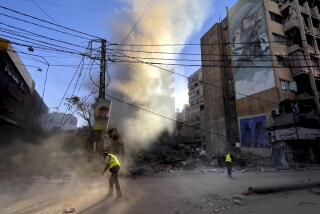Twitter and other social media now another front in Gaza attack
While Israel launched its surprise attack Wednesday on Gaza, it declared it to the world on Twitter, arguing its case for the new campaign against Hamas in less than 140 characters.
Minute by minute, the Israel Defense Forces fed followers information and arguments on the strike. At their computers, Internet users could click through aerial photos, check updates on the offensive and watch a YouTube video of the strike killing the Hamas military chief.
At one point, the Israeli military traded Twitter barbs with Hamas. “We recommend that no Hamas operatives, whether low level or senior leaders, show their faces above ground in the days ahead,” the @IDFSpokesperson account tweeted Wednesday.
The Hamas military wing tweeted back, “Our blessed hands will reach your leaders and soldiers wherever they are (You Opened Hell Gates on Yourselves).”
“This is a new reality of war,” said Heather Hurlburt, executive director of the National Security Network think tank in Washington. “And I worry that it’s going to make it harder to stand down.”
As both sides have embraced Twitter and other online platforms as information and propaganda tools, the real warfare in Gaza has been joined by a virtual battle played out in real time.
“I just wonder why we didn’t do it before,” said Gabriel Weimann, professor of communications at the University of Haifa. “The Israelis were often criticized for fighting well, but explaining the war in a lousy way.”
Hamas and other groups sympathetic to the Palestinians have long been active online, spreading messages through online forums. Social media analysts say Israeli forces stepped up their efforts after being outflanked online during the deeply controversial Gaza flotilla raid two years ago, when nine pro-Palestinian activists were killed in a clash with Israeli commandos.
“The IDF is beginning to treat cyberspace as an additional front,” said Michael Dahan, professor of Internet and politics at Sapir College in Israel. “It puts the audience in the front seat of war, but what they see is strictly controlled by the IDF.”
Hamas tweeted its own newsfeed about targeting Israeli fighter jets and bases and spread pictures of anguished civilians with slogans condemning the offensive. Palestinian activists on the ground, meanwhile, deployed social media to spread messages about the attacks’ effects.
“I was a bit cynical at first. What are a few Facebook groups or Twitter messages in the face of these big powers?” said Miriyam Aouragh, an Oxford University anthropologist teaching in the West Bank. “But they’ve organized an enormous number of protests in such a short time.”
Whether their messages work in swaying outside opinion is unclear. For instance, Aouragh said even when Palestinian activists share eyewitness reports about the toll of attacks, media outlets may not pick them up.
Bringing an online front into the longstanding conflict could also cause new problems: The pressure to fire back a rapid response could trigger more inflammatory talk, Hurlburt warned. Aouragh also questions whether outside fascination with the new, technological ways these battles are playing out has become a frustrating distraction from bloody events on the ground.
“I find it strange that there are people who find it thrilling to watch someone being assassinated in real time,” Dahan said. “In some cases, it looks perversely like a game.”
ALSO:
Egypt calls on U.S. to help stop Gaza fighting
Gazans brace for a bitter confrontation with Israel
Tamils seek probe after U.N. faults itself in Sri Lanka war report
More to Read
Sign up for Essential California
The most important California stories and recommendations in your inbox every morning.
You may occasionally receive promotional content from the Los Angeles Times.










